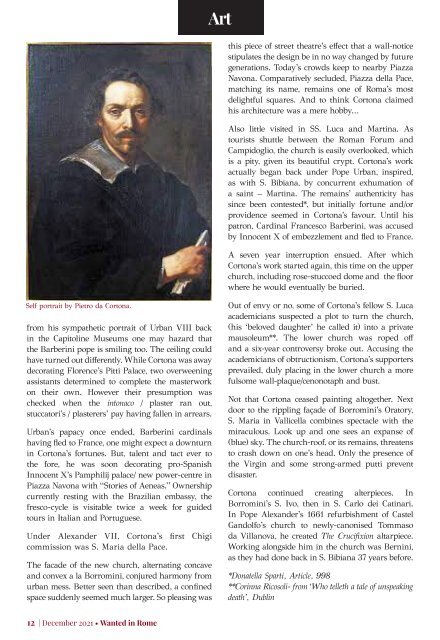Wanted in Rome DEC 2021
Create successful ePaper yourself
Turn your PDF publications into a flip-book with our unique Google optimized e-Paper software.
Art<br />
this piece of street theatre’s effect that a wall-notice<br />
stipulates the design be <strong>in</strong> no way changed by future<br />
generations. Today’s crowds keep to nearby Piazza<br />
Navona. Comparatively secluded, Piazza della Pace,<br />
match<strong>in</strong>g its name, rema<strong>in</strong>s one of Roma’s most<br />
delightful squares. And to th<strong>in</strong>k Cortona claimed<br />
his architecture was a mere hobby…<br />
Also little visited <strong>in</strong> SS. Luca and Mart<strong>in</strong>a. As<br />
tourists shuttle between the Roman Forum and<br />
Campidoglio, the church is easily overlooked, which<br />
is a pity, given its beautiful crypt. Cortona’s work<br />
actually began back under Pope Urban, <strong>in</strong>spired,<br />
as with S. Bibiana, by concurrent exhumation of<br />
a sa<strong>in</strong>t – Mart<strong>in</strong>a. The rema<strong>in</strong>s’ authenticity has<br />
s<strong>in</strong>ce been contested*, but <strong>in</strong>itially fortune and/or<br />
providence seemed <strong>in</strong> Cortona’s favour. Until his<br />
patron, Card<strong>in</strong>al Francesco Barber<strong>in</strong>i, was accused<br />
by Innocent X of embezzlement and fled to France.<br />
A seven year <strong>in</strong>terruption ensued. After which<br />
Cortona’s work started aga<strong>in</strong>, this time on the upper<br />
church, <strong>in</strong>clud<strong>in</strong>g rose-stuccoed dome and the floor<br />
where he would eventually be buried.<br />
Self portrait by Pietro da Cortona.<br />
from his sympathetic portrait of Urban VIII back<br />
<strong>in</strong> the Capitol<strong>in</strong>e Museums one may hazard that<br />
the Barber<strong>in</strong>i pope is smil<strong>in</strong>g too. The ceil<strong>in</strong>g could<br />
have turned out differently. While Cortona was away<br />
decorat<strong>in</strong>g Florence’s Pitti Palace, two overween<strong>in</strong>g<br />
assistants determ<strong>in</strong>ed to complete the masterwork<br />
on their own. However their presumption was<br />
checked when the <strong>in</strong>tonaco / plaster ran out,<br />
stuccatori’s / plasterers’ pay hav<strong>in</strong>g fallen <strong>in</strong> arrears.<br />
Urban’s papacy once ended, Barber<strong>in</strong>i card<strong>in</strong>als<br />
hav<strong>in</strong>g fled to France, one might expect a downturn<br />
<strong>in</strong> Cortona’s fortunes. But, talent and tact ever to<br />
the fore, he was soon decorat<strong>in</strong>g pro-Spanish<br />
Innocent X’s Pamphilij palace/ new power-centre <strong>in</strong><br />
Piazza Navona with “Stories of Aeneas.” Ownership<br />
currently rest<strong>in</strong>g with the Brazilian embassy, the<br />
fresco-cycle is visitable twice a week for guided<br />
tours <strong>in</strong> Italian and Portuguese.<br />
Under Alexander VII, Cortona’s first Chigi<br />
commission was S. Maria della Pace.<br />
The facade of the new church, alternat<strong>in</strong>g concave<br />
and convex a la Borrom<strong>in</strong>i, conjured harmony from<br />
urban mess. Better seen than described, a conf<strong>in</strong>ed<br />
space suddenly seemed much larger. So pleas<strong>in</strong>g was<br />
Out of envy or no, some of Cortona’s fellow S. Luca<br />
academicians suspected a plot to turn the church,<br />
(his ‘beloved daughter’ he called it) <strong>in</strong>to a private<br />
mausoleum**. The lower church was roped off<br />
and a six-year controversy broke out. Accus<strong>in</strong>g the<br />
academicians of obtructionism, Cortona’s supporters<br />
prevailed, duly plac<strong>in</strong>g <strong>in</strong> the lower church a more<br />
fulsome wall-plaque/cenonotaph and bust.<br />
Not that Cortona ceased pa<strong>in</strong>t<strong>in</strong>g altogether. Next<br />
door to the rippl<strong>in</strong>g façade of Borrom<strong>in</strong>i’s Oratory,<br />
S. Maria <strong>in</strong> Vallicella comb<strong>in</strong>es spectacle with the<br />
miraculous. Look up and one sees an expanse of<br />
(blue) sky. The church-roof, or its rema<strong>in</strong>s, threatens<br />
to crash down on one’s head. Only the presence of<br />
the Virg<strong>in</strong> and some strong-armed putti prevent<br />
disaster.<br />
Cortona cont<strong>in</strong>ued creat<strong>in</strong>g alterpieces. In<br />
Borrom<strong>in</strong>i’s S. Ivo, then <strong>in</strong> S. Carlo dei Cat<strong>in</strong>ari.<br />
In Pope Alexander’s 1661 refurbishment of Castel<br />
Gandolfo’s church to newly-canonised Tommaso<br />
da Villanova, he created The Crucifixion altarpiece.<br />
Work<strong>in</strong>g alongside him <strong>in</strong> the church was Bern<strong>in</strong>i,<br />
as they had done back <strong>in</strong> S. Bibiana 37 years before.<br />
*Donatella Sparti, Article, 998<br />
**Cor<strong>in</strong>na Ricosoli- from ‘Who telleth a tale of unspeak<strong>in</strong>g<br />
death’, Dubl<strong>in</strong><br />
12 | December <strong>2021</strong> • <strong>Wanted</strong> <strong>in</strong> <strong>Rome</strong>
















